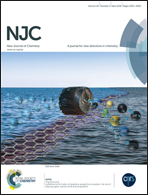Synthesis and photoluminescence of Bi3+,Eu3+ doped CdWO4 phosphors: application of energy level rules of Bi3+ ions
Abstract
Bi3+,Eu3+ doped CdWO4 phosphors have been synthesized using a co-precipitation method and regular micro-rods were obtained in Bi3+ or Eu3+ single-doped samples. X-ray diffraction, scanning electron microscopy, UV-vis spectrophotometry, and photoluminescence and decay time measurements were used to characterize the as-prepared samples. CdWO4:Bi3+ and CdWO4:Bi3+,Eu3+ can be excited ranging from 250 to 400 nm. The excitation at 350 nm was assigned to be the Bi3+ 1S0 → 3P1 transition according to the energy level rules of Bi3+ ions. The origin of O–W charge transfer transition has been analyzed using the calculated band structure and density of states of CdWO4 based on density functional theory. The approach to charge compensation was two impurity ions substituting for three Cd2+ sites. Energy transfer properties from the WO6 group to Bi3+ as well as from Bi3+ to Eu3+ were discussed. The mechanism of energy transfer from Bi3+ to Eu3+ was determined to be the quadrupole–quadrupole interaction and the critical distance of energy transfer from Bi3+ to Eu3+ was calculated to be 15.31 Å. The quantum efficiency, CIE chromaticity and thermal quenching properties have also been investigated.


 Please wait while we load your content...
Please wait while we load your content...